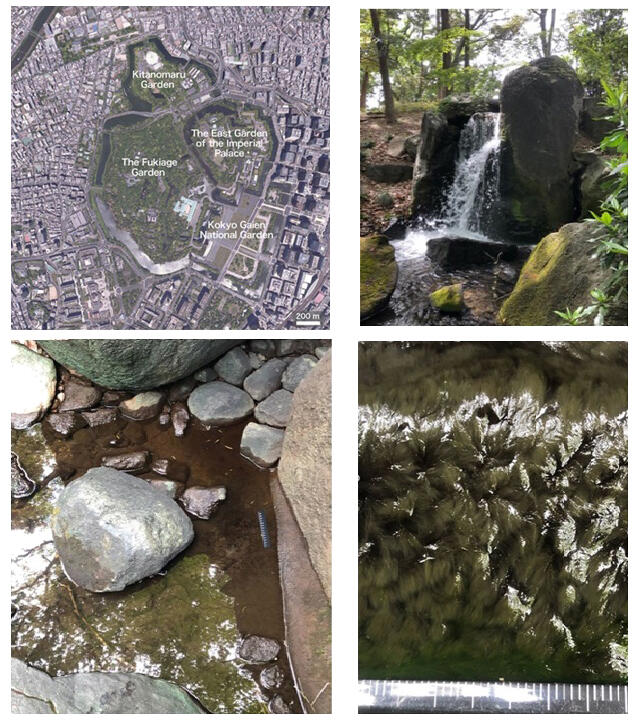Senior Curator Taiju Kitayama of the Department of Botany at the National Museum of Nature and Science (NMNS), and Assistant Professor Masahiro Suzuki at the United Graduate School of Agricultural Sciences at Kagoshima University, collected a freshwater red alga from the family Batrachospermaceae in the Kitanomaru area of the Kokyo Gaien National Garden (Chiyoda City, Tokyo Prefecture) as part of the research project "A study of biota changes in urban environments over the past 150 years—Analysis of specimens collected mainly from the Imperial Palace in Central Tokyo," sponsored by NMNS. Through morphological observations and genetic analysis, the alga was identified as a new species. The new species was described and named Sheathia yedoensis (Japanese name: Kitanomaru-kawamozuku) because it was found in a park that was originally the area called Kitanomaru in the former Edo Castle.

(Top right) The waterfall, ''Taki,'' inside Kitanomaru Garden.
(Bottom left) The basin of the waterfall.
(Bottom right) The present alga, Sheathia yedoensis sp. nov. on the basin of the waterfall.
Provided by the National Museum of Nature and Science, Tokyo
Members of the family Batrachospermaceae are a group of freshwater red algae, with approximately 240 species known worldwide. In Japan, 23 species, one variety, and one cultivar are reported to exist. However, many of these species require spring-quality clear water to survive and are at risk of extinction due to the loss of this water and water pollution caused by urbanization.
Although Tokyo is one of the most urbanized areas in Japan, the Imperial Palace in the center of Tokyo is home to a wide variety of species. The NMNS has conducted two comprehensive surveys of the flora and fauna in the Imperial Palace's Fukiage Garden. These surveys recorded nearly 6,000 animal and plant species, including 12 algal species, some of which are at risk of extinction.
For comparisons with the rich biological environment of the Fukiage Garden, the algal flora in Kitanomaru Park was surveyed in parallel with that in the Fukiage Garden in phase III of the aforementioned research project, which is being conducted from 2021 to 2025. Kitanomaru Park, similar to Fukiage Garden, was originally part of the former Edo Castle. Since its opening in 1969, it has been maintained as a public park and remains open daily. Researchers anticipated that the natural environment of Kitanomaru Park would differ from that of Fukiage Garden, which has been preserved with minimal human intervention.
On April 14, 2023, during the first-ever survey of the algal flora in Kitanomaru Park, it was discovered that the sporophyte generation of the Batrachospermaceae algae was growing in the basin of an artificially constructed waterfall within the park. The reddish-brown, brush-like thalli, reaching up to 4 mm in height, were attached to the bedrock at the bottom of the waterfall basin, forming a dense covering over the surface. Microscopic observations revealed that the thallus consists of uniseriate filaments and forms monosporangia on its branches (laterals). Morphologically, the specimens were likely sporophytes of the family Batrachospermaceae. However, identifying the exact species was challenging, as no male or female gametophytes were found.
In response to this the group performed DNA analysis and found that this alga was an undescribed species of the genus Sheathia. It is the first new algal species of the family Batrachospermaceae reported in Tokyo. The family Batrachospermaceae is a group of algae that inhabit clean water streams. Algae of this family are usually found in natural springs, rural streams, and other environments with clean water, but the new species was found in a man-made waterfall in Kitanomaru Park.
The unique environment of the artificially maintained and managed waterfall likely plays a crucial role in the inhabitation and survival of this alga. This species was given the scientific name S. yedoensis and the Japanese name "Kitanomaru-kawamozuku" because it grows in the area that was originally the former Edo Castle's Kitanomaru area. Thus far, this species has not been recorded in any other regions of Japan or other countries, making it endemic to Japan. Currently, although this population has been confirmed to be growing in the same state, no gametophytes have been identified.
It is necessary to determine, through culture experiments and other methods, whether the alga has lost its gametophytes or if they develop under suitable environmental conditions. The research group will continue to monitor the population on a regular basis. This species, along with Torularia atra (in the threatened I category of the Ministry of the Environment) that grows in the Fukiage Garden's Dokanbori, could be an indicator of a clean water environment.
Journal Information
Publication: J-STAGE
Title: Sheathia yedoensis, a New Species of the Freshwater Red Alga (Batrachospermaceae, Rhodophyta) from Kitanomaru Park, Adjacent to the Imperial Palace, Tokyo, Japan
DOI: 10.50826/bnmnsbot.50.4_131
This article has been translated by JST with permission from The Science News Ltd. (https://sci-news.co.jp/). Unauthorized reproduction of the article and photographs is prohibited.




